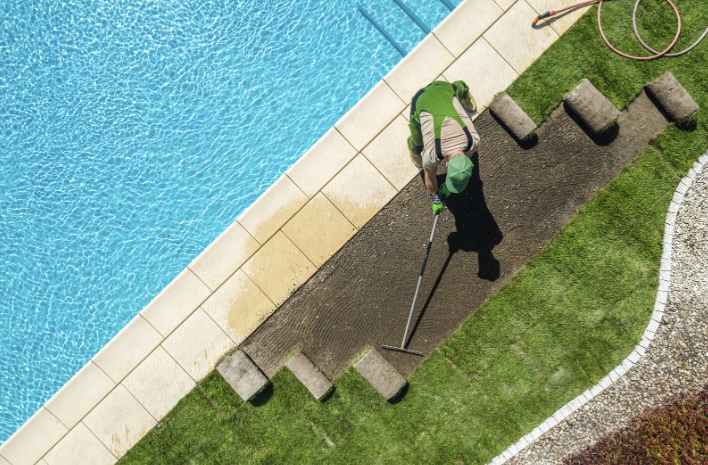In the milieu, our work depends on competition, as much as the grasses and shrubs that we grow and take care of. To excel, mastering the art of SEO is not only beneficial, it’s a must. For online landscape businesses to enrich their standings in the Digital soil, SEO is the water and sunlight they need in order to have a productive website. In this article, we are dealing with the fine points of SEO for landscapers and providing you with some exciting tips that will definitely let your landscaping enterprise thrive in the huge digital world.
Landscaping SEO: The Root of Online Success
Landscaping SEO, Search Engine Optimization, is a crucial element in the marketing plan of landscaping business in the current digital age. It encompasses the optimization of different aspects of a landscape company’s online presence so that the company could be highly visible in search engine results. Optimizing their SEO work, landscapers will increase the traffic to their websites, generate clients and consequently develop their business. Let’s delve into the key components of effective landscaping SEO:
Keyword Optimization
Keyword optimization (KO) involves the planning and execution of the correct use of keywords in website content in order to allow for better ranking in search engines. A key strategy for landscaping companies is to determine and work on targeting keywords which will probably be used by potential customers in their online quest of seeking landscaping services. Here are some key points to consider:
- Keyword Research: Utilize search engine marketing tools such as Google Keyword Planner and SEMrush for identifying high-volume keywords to do with landscaping, namely “landscaping services,” “landscape design,” and “garden maintenance.”
- On-Page Optimization: Season them into almost all contents of the website, such as headings, meta descriptions, image alt tags, and content of the body. Nevertheless, don’t overdo the keywords. Otherwise, they will have an adverse effect on your customers’ experience as well as SEO.
- Local Keywords: Underline local keywords you would like to use if your landscape company serves a particular area. For example, use phrases like “landscape company in [city]” or “close by landscape designer” for people from the neighborhood.
Quality Content
Keyword optimization is another factor that also terminates as a key but producing good-quality content remains the most okay as it engages the website visitors and gives you a good search engine ranking. Here’s how landscapers can leverage content marketing for SEO:
- Educational Blog Posts: Write a series of blogs that bring valuable info and ideas about landscaping to your readers, for example: check out our lawn care tips, or get inspired by our garden design posts, or find out how to maintain your garden season after season, or read about sustainability in landscaping.
- Visual Content: Add tasteful visual elements such as photos, video clips, charts, and before and after examples of your landscape projects to tantalize your audience. Visual content not only increases user experience but also promotes online marketing activities creating social media sharing of articles and obtaining backlinks.
- Case Studies and Testimonials: Show the benefits of working with you, share real customers’ compliments, and provide real-life examples of your work to build trust and clearly convey your value. Providing helpful tips and demonstration videos as content may influence the prospects to trust you more and at the same time pitching your services against your competitors.
User-Friendly Design
Besides qualitative content and keyword optimization, the look-and-feel and the functionality of your website are another virtual backbone of your SEO. Here are some tips for creating a user-friendly website:
- Mobile Optimization: Launch a website that is adaptable to tablets and smartphones and therefore displays correctly on different screen sizes and devices. In the age where smartphones and tablets are used more and more for web surfing, it is crucial to make the websites optimized for mobile if you want to offer a desired user experience and better position your pages in the search engines.
- Fast Loading Speed: For enhancing your website’s loading speed, try to reduce the size of large picture files, and use caching on your browser, as well as a reliable web host. A quick website not only helps users to experience the site but also hits the shelf by improving search engine ranking and reduces bounce rates.
- Intuitive Navigation: Arrange your website’s navigation menu with the needed delivery, hence making it easy for visitors to find what they are looking for. Apply being descriptive in products/menu items, and provide search options for easy navigation.
Landscaping SEO Services: Cultivating Your Online Presence
Landscaping SEO agencies can help upscale performance, which is why finding a good landscaping SEO service is more often than not advantageous. These methods can include many different strategies and approaches to make the best use of your online presence and to get your website ranked higher on search engines. Let’s explore the key components of landscaping SEO services in detail:
Website Optimization
Website optimization concentrates on the technical details of the website so that it can have the best performance and can be the most user-friendly. This ongoing process addresses elements like loading time, responsiveness, and overall architectural planning of the site. Here’s a breakdown of key elements:
- Loading Times: The number one factor that will keep people on your site and helps with their SEO rankings, is how fast the site loads. This can happen by recording pictures, reduction in code, and usage of server resources to decrease load time.
- Responsiveness: While mobile devices together with desktop devices are the most popular web browsing devices nowadays, having a responsive website design that is able to adapt quickly to different screen sizes is an absolute necessity for a website to be successful. This provides both improved user experience and also SEO performance as Google recently ranked mobile-friendly web pages higher for its search results.
- Site Structure: Website organization should be in accordance with a logic that makes it easier for both users and search engines to get the content they are looking for. This encompasses notable navigation menus, descriptive URLs, and internal linking that links related pieces of content.
Content Creation
Topnotch content is a prerequisite for such endeavors in landscaping SEO. Landscaping SEO specialists were found to often outline content creation as a central aspect of their scope of work. Here’s how content creation contributes to SEO success:
- SEO-Optimized Articles and Blog Posts: Building articles and blog posts that are factual and captivating, as well as including critical keywords, will lead to quality traffic you might get when you optimize your website. Along these lines, these oilers will let the readers know how educated you are in landscaping, and at the same time, they will supply very good information for your audience.
- Keyword Research: Keyword research plays a significant role in SEO conceptualization because SEO experts can find the keywords and phrases that customers search for when they make queries. By tactically adding these keywords to your content, you will give yourself a competitive advantage in that you might as well rank on top of the SERPs.
- Regular Updates: Regular updates and content circulation not only fulfill the requirements of users but also benefit search engines that recognize fresh content and rank the sites accordingly. Publish localized landscaping tips, for instance, if it is the season. You may as well use this opportunity to display your recent projects or share your own industry thoughts. By doing so, you will be able to generate that ongoing traffic to your site.
Link Building
Estate of link building turns out to be a key element of landscaping SEO services. The philosophy is based on acceptance of links from other reliable websites in return to the performance of your site, thereby raising your site authority and credibility. Here’s how link building works:
- Quality Over Quantity: The number of backlinks is just one aspect of the link building equation and the quality of those links should be given a higher priority. The SEO team aims at obtaining and creating links in the landscaping market, as well as in relevant niches.
- Natural Link Acquisition: Development of organic links is the main tool for long-term success of SEO strategy. Such tactics could range from securing guest blogging opportunities through outreach efforts to the development of viral and shareable content that will bring organic backlinks from other sites.
- Diversification: Various methods including citing new websites and different authoritative sources can help you reduce risks of algorithmic penalties and eventually lead to a sustainable SEO strategy.
SEO for Landscaping Companies: Branching Out

Being that landscaping services are inextricably bound with specific geographic places, local optimization for search would determine business success in this industry. Let’s explore the key components of SEO for landscaping companies in greater detail:
Google My Business
Google My Business (GMB) is the right platform that enables you to enhance your local search visibility and consequently attract potential customers. By setting and improving your GMB profile, you can be certain that your landscaping company will be ranked highly among Google’s local search results. Here’s how to leverage GMB effectively:
- Claim Your Listing: Verify your business on Google My Business if you haven’t done so already. Give out exact and fresh details on your landscaping services, including the business name, address, phone number, and operational hours as well.
- Optimize Your Profile: Fill in all the specified parts of your GMB profile including business categories, descriptions, photos, and customer reviews. Use the keywords that are relevant to your business to improve the visibility to local searches.
- Encourage Reviews: It is important to increase the amount of positive reviews on your GMB profile that are posted by satisfied customers. Reviewing a good reputation not only is going to improve your business’s credibility but also increase the local search results.
Local Keywords
Local rapport is highly necessary to acquire customers through targeting locations in your landscaping business. Through the utilization of your targeted keywords that have been placed thoughtfully on each content piece of your web, this can give you a chance of appearing on the first page of the local search engine rankings and consequently connecting with the prospective customers of your local area. Here’s how to optimize for local keywords:
- Keyword Research: As a way of carrying out keyword research, find out various terms that relate to landscaping services in your area, which people are likely to search for. Apply phrases like ” landscaping services in [Your City],” ” landscape design [Your City],” and ” garden maintenance [Your City]”
- On-Page Optimization: Incorporate the local keywords organically into the content of your website, be it from titles or meta descriptions to paragraphs. Focus on the delivery of vital information to your landscape company while being in tune with the relevant local search terms to improve your search ranking.
- Localized Content: Construct localized content that addresses the variances and preferences of your particular audience in individual geographical zones. Such can be made of blog posts, case studies, or project galleries where there are illustrations of landscape development activities done in various neighborhoods.
Local Link Building
The process of building local links contributes significantly to boosting the visibility of your landscaping company amongst the other firms in your area. Through acquiring incoming links from the local companies, institutions, and directories, you can enlarge the authority and value of your website in local search engine results. Here’s how to pursue local link building opportunities:
- Partner with Local Businesses: Partner with other local business organizations like nursery, home improvement store and real estate agencies for reciprocal linking and referral processes. Developing productive relations that contribute to valuable referral links and showing up in the local community can be done through this.
- Submit to Local Directories: Ensure that your landscape business is listed in online directories and in the local business listings that are industry-related in your local area. This involves platforms like Yelp, Yellow Pages, and regional chambers of commerce web pages. The primary factor leading to a successful local SEO is uniform NAP (Name, Address, Phone Number) information across all these directories.
- Sponsor Local Events or Charities: Regardless of whether you support your neighborhood team that competes at the regional level, you can get involved by sponsoring community events or supporting local charities. However, when you participate in local events not only are you building your brand recall but also you are given chances for link backs from event websites, or local newspapers covering the event.
Analyzing Your SEO Landscape: Metrics and Tools
The best way to measure the performance of the landscaper SEO method is by an application of analytics tools. With these tools, you get a tailor-made diagnosis of your SEO performance, based on which you can evaluate your strengths and weaknesses, as well as identify new areas, where is the ground for improvement. Let’s delve into the key metrics and tools used for analyzing your SEO landscape:
Google Analytics
Website optimization is impossible without the powerful web analytics tool Google Analytics which provides very detailed insights into the basic website traffic, user behavior, and engagement results. With the use of Google Analytics, the landscape companies take advantage of continuous evaluation of website performance and see how the SEO actions affect their websites. Here are some key metrics to monitor:
- Website Traffic: Review the total visitors to your site within a certain period and also the sources of traffic including (organic, direct, referral, etc.). It thus helps you to understand the effectiveness of how the SEO strategies are driving traffic to the site as well.
- User Behavior: Consider measuring user behavior metrics, which include bounce rate, average session duration, and pages per session. A high bounce rate or a low average session duration may signal UI and content relevance issues on the website.
- Conversion Tracking: Install the special goals and conversion tracking in Google Analytics in order to analyze the attention of the visitors on a specific action, like form submissions, phone calls, or online purchases. This way you can evaluate that SEO helps you in lead generation or sales.
SEMrush or Ahrefs
SEMrush and Ahrefs are comprehensive SEO tools that offer advanced features for keyword analysis, competitive research, and performance tracking. These tools provide valuable insights into keyword rankings, backlink profiles, and competitor strategies. Here’s how landscapers can leverage SEMrush or Ahrefs for SEO analysis:
- Keyword Analysis: Use SEMrush or Ahrefs to conduct keyword research and identify high-value keywords relevant to your landscaping business. Analyze keyword search volume, competition level, and potential traffic to prioritize your SEO efforts.
- Competitive Insights: Explore competitor websites using SEMrush or Ahrefs to gain insights into their SEO strategies, top-performing keywords, and backlink profiles. This allows you to benchmark your performance against competitors and identify areas for improvement.
- Backlink Analysis: Assess the quality and quantity of backlinks pointing to your website using the backlink analysis tools provided by SEMrush or Ahrefs. Identify opportunities to acquire new backlinks from authoritative websites and monitor the effectiveness of your link building efforts.
On-Page SEO: Planting the Seeds for Visibility

On-page SEO plays a crucial role in optimizing individual web pages to improve search engine visibility and attract organic traffic. For landscaping companies, effective on-page SEO techniques are essential for showcasing services, attracting potential clients, and ultimately growing the business. Let’s explore key strategies and techniques for on-page SEO in the landscaping industry:
Meta Tags
Meta tags are HTML elements that provide information about a web page to search engines and website visitors. Crafting compelling meta titles and descriptions is essential for on-page SEO success. Here’s how to optimize meta tags for landscaping websites:
- Meta Titles: Create concise and descriptive meta titles that include relevant keywords, such as ‘landscapers SEO’ or ‘landscape design services.’ Aim for a length of around 50-60 characters to ensure visibility in search engine results pages (SERPs).
- Meta Descriptions: Craft compelling meta descriptions that accurately summarize the content of the web page and entice users to click through. Incorporate target keywords naturally while providing valuable information about your landscaping services. Keep meta descriptions within 150-160 characters for optimal display in SERPs.
Header Tags
Header tags (H1, H2, H3, etc.) are HTML elements used to structure content on a web page. Proper use of header tags not only improves readability for website visitors but also signals the importance of specific sections to search engines. Here’s how to optimize header tags for on-page SEO:
- H1 Tags: Use H1 tags for the main heading of the page, typically the title or primary focus keyword. Ensure that the H1 tag accurately reflects the topic of the page and includes relevant keywords related to landscaping services.
- H2 and H3 Tags: Use H2 and H3 tags to organize subheadings and subsections within the content. Incorporate variations of your target keywords naturally into these headers to provide structure and context for both users and search engines.
Image Optimization
Optimizing images is an often overlooked aspect of on-page SEO that can significantly impact website performance and user experience. Here’s how to optimize images for better search engine visibility:
- Image Compression: Compress images to reduce file size and improve page loading speed. Large, uncompressed images can slow down your website, leading to poor user experience and lower search rankings.
- Descriptive Alt Tags: Assign descriptive alt tags to images that accurately describe the content or purpose of the image. Include relevant keywords in alt tags to provide additional context to search engines and improve accessibility for visually impaired users.
Off-Page SEO: Spreading Your Roots
Off-page SEO is a vital aspect of optimizing landscaping websites for improved search engine visibility and authority. Unlike on-page SEO, which focuses on optimizing individual web pages, off-page SEO revolves around building your website’s authority and reputation through external factors such as backlinks and online presence. Let’s delve into key off-page SEO strategies tailored for landscaping companies:
Guest Blogging
Guest blogging involves writing articles or blog posts for other websites within the landscaping industry or related niches. By contributing valuable content to reputable websites, you can establish yourself as an authority in your field and attract relevant traffic back to your own site through backlinks. Here’s how to effectively leverage guest blogging for off-page SEO:
- Research Target Websites: Identify authoritative websites, blogs, and online publications within the landscaping industry where you can contribute guest posts. Look for platforms that align with your target audience and have a strong online presence.
- Create High-Quality Content: Write informative and engaging articles that provide valuable insights, tips, or industry expertise. Incorporate relevant keywords naturally and include a backlink to your website within the content or author bio.
- Build Relationships: Cultivate relationships with website owners, editors, and influencers in the landscaping community. Networking with industry professionals can lead to guest blogging opportunities and collaborative partnerships that benefit both parties.
Social Media Marketing
Social media marketing plays a significant role in off-page SEO by enhancing your online presence, driving traffic to your website, and fostering engagement with your target audience. Here’s how landscaping companies can leverage social media platforms effectively:
- Choose the Right Platforms: Identify social media platforms that resonate with your target audience and align with your brand’s messaging. Popular platforms for landscaping companies include Facebook, Instagram, Pinterest, and Houzz.
- Share Engaging Content: Regularly share compelling content, such as project photos, landscaping tips, before-and-after transformations, and behind-the-scenes glimpses of your work. Encourage interaction by asking questions, running polls, and responding to comments from followers.
- Promote Your Website: Use social media channels to promote blog posts, special offers, events, and other website content. Include clear calls-to-action (CTAs) and links to drive traffic back to relevant pages on your website.
- Engage with Your Audience: Actively engage with your audience by responding to comments, messages, and inquiries in a timely manner. Building relationships and fostering community engagement can lead to increased brand loyalty and advocacy.
Technical SEO: Laying the Groundwork
Technical SEO is a fundamental component of optimizing landscaping websites for better search engine performance. It involves optimizing the technical aspects of your website to ensure it is easily crawled, indexed, and ranked by search engines. By focusing on technical SEO, landscaping companies can improve their website’s visibility and user experience. Let’s explore key technical SEO considerations and best practices in detail:
Site Speed
Site speed refers to how quickly your website loads and responds to user requests. A fast-loading website not only enhances user experience but also positively impacts search engine rankings. Here’s how to optimize site speed for better technical SEO:
- Tools for Analysis: Use tools like Google PageSpeed Insights, GTmetrix, or Pingdom to analyze your website’s loading times and identify areas for improvement. These tools provide detailed insights and recommendations for optimizing page speed.
- Optimization Techniques: Implement optimization techniques such as image compression, browser caching, minification of CSS and JavaScript files, and reducing server response times. Addressing these factors can significantly improve your website’s loading speed.
- Mobile Optimization: Prioritize mobile optimization to ensure that your website loads quickly and performs well on mobile devices. With the increasing prevalence of mobile search, Google prioritizes mobile-friendly websites in its search results.
Mobile Optimization
Mobile optimization is essential for ensuring that your website is accessible and user-friendly across various devices, including smartphones and tablets. Here’s how to optimize your website for mobile devices:
- Responsive Design: Implement a responsive design that automatically adjusts the layout and content of your website based on the user’s screen size and device orientation. This ensures a consistent and optimized experience for mobile users.
- Mobile-Friendly Features: Optimize font sizes, button sizes, and touch elements to enhance usability on touchscreen devices. Avoid using Flash or other technologies that may not be compatible with mobile browsers.
- Mobile-Friendly Testing: Use Google’s Mobile-Friendly Test tool to evaluate your website’s mobile-friendliness and identify any issues that need to be addressed. This tool provides specific recommendations for improving mobile usability.
Secure Connection
Implementing a secure connection using HTTPS (Hypertext Transfer Protocol Secure) is essential for protecting user data and ensuring the integrity of your website. Here’s how to implement HTTPS for better technical SEO:
- SSL Certificate: Obtain and install an SSL (Secure Sockets Layer) certificate on your web server to encrypt data transmitted between the user’s browser and your website. This helps protect sensitive information such as passwords, payment details, and personal data.
- Redirects: Set up 301 redirects to ensure that all HTTP URLs are redirected to their HTTPS counterparts. This helps maintain SEO equity and prevents duplicate content issues.
- Update Internal Links: Update internal links within your website to point to HTTPS URLs instead of HTTP URLs. This ensures a seamless transition to HTTPS and avoids mixed content warnings.
Content Marketing: Fertilizing Your SEO Strategy

Content marketing is a vital component of any successful SEO strategy for landscapers. By creating and sharing valuable content that resonates with your target audience, you can enhance your website’s visibility, attract organic traffic, and establish your landscaping company as an industry authority. Let’s explore key content marketing tactics tailored for landscapers in detail:
Blog Posts
Blog posts are a versatile and effective way to engage with your audience, demonstrate your expertise, and improve your website’s search engine rankings. Here’s how to leverage blog posts for content marketing in the landscaping industry:
- Topics: Write blog posts about landscaping tips, trends, and case studies that address the needs and interests of your target audience. Consider topics such as seasonal gardening advice, lawn care tips, sustainable landscaping practices, or project showcases.
- Keyword Optimization: Incorporate relevant keywords related to landscaping services, such as “landscape design,” “garden maintenance,” or “hardscaping,” into your blog posts. Conduct keyword research to identify high-volume and low-competition keywords to target.
- Quality Content: Ensure that your blog posts provide valuable information, insights, and solutions to your audience’s problems. Use a conversational tone, include engaging visuals, and break up text with subheadings, bullet points, and images to enhance readability.
Infographics
Infographics are visually appealing and shareable assets that convey complex information in a digestible format. They can be highly effective for attracting attention, generating backlinks, and improving your website’s SEO. Here’s how to leverage infographics in your content marketing strategy:
- Data Visualization: Create infographics that visually represent data, statistics, or trends related to landscaping, such as water usage statistics, garden design principles, or environmental impact assessments.
- Visual Branding: Incorporate your landscaping company’s branding elements, such as logos, colors, and fonts, into your infographics to reinforce brand recognition and awareness.
- Promotion: Share your infographics on your website, social media channels, and industry forums to increase visibility and encourage sharing. Include an embed code or sharing buttons to make it easy for others to share your infographic on their own websites and social media profiles.
Videos
Videos are engaging and immersive content formats that can showcase your landscaping projects, demonstrate techniques, and provide valuable educational content to your audience. Here’s how to leverage videos for content marketing:
- How-To Guides: Create instructional videos that demonstrate landscaping techniques, DIY projects, or garden maintenance tips. Use visuals, step-by-step instructions, and clear narration to guide viewers through the process.
- Project Showcases: Showcase your landscaping projects through video tours, before-and-after transformations, or client testimonials. Highlight the quality of your work, attention to detail, and the satisfaction of your clients.
- Optimization: Optimize your videos for search engines by incorporating relevant keywords into video titles, descriptions, and tags. Choose descriptive and keyword-rich filenames for your video files to improve discoverability.
Conclusion
In the lush landscape of digital marketing, SEO for landscaping businesses is not just a luxury – it’s a necessity. By implementing the strategies outlined in this article, from on-page optimization to content marketing, your landscaping business can achieve robust online growth and reach new heights. Remember, like a well-tended garden, the results of good SEO practices don’t happen overnight but grow over time, bringing lasting visibility and success.
FAQ
SEO is crucial for landscaping businesses looking to increase their online visibility, attract more website visitors, and convert those visitors into clients.
While it’s possible to implement some SEO strategies yourself, professional landscaping SEO services can offer more comprehensive and effective solutions.
SEO is a long-term strategy. Results can vary, but typically, noticeable improvements can be seen within 3-6 months.
Yes, local SEO focuses on optimizing your online presence to attract local customers and is particularly important for location-based businesses like landscaping companies.

